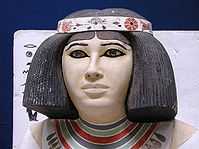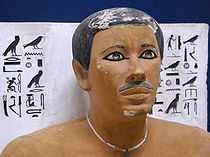Nofret
| Nofret (Nfr-t) | |
|---|---|
 Nofret's statue, Cairo Museum | |
| Born | Nofret |
Resting place | mastaba at Meidum |
| Other names | Nefret, Neferet |
| Title | Princess consort of Egypt |
| Religion | Ancient Egyptian religion |
| Spouse(s) | Prince Rahotep |
| Children |
Prince Djedi Prince Itu Prince Neferkau Princess Mereret Princess Nedjemib Princess Sethtet |
Nofret was a noblewoman and princess who lived in Ancient Egypt during the 4th dynasty of Egypt.
Etymology
Nefert means "beautiful". Nofret is alternatively known as Nefert or Neferet.
Biography
Nofret's parents are not known. Nofret married Prince Rahotep, who was a son of Pharaoh Sneferu. She had three daughters and three sons with Rahotep.[1]
Nofret was buried with her husband in mastaba 16 at Meidum.[2] In 1871, beautiful statues of Rahotep and Nofret were found.[3] Nofret is depicted with a black wig and very fair face. Her titles in hieroglyphs on the back of her chair name her as "King's Acquaintance".[4] The statues are now in the Cairo Museum.[5]
Children
Children of Nofret and Rahotep were:
- Prince Djedi
- Prince Itu
- Prince Neferkau
- Princess Mereret
- Princess Nedjemib
- Princess Sethtet[1]
The 2 statues, Nofret and Rahotep
The pair of statues, for Nofret and Rahotep, have the standard difference of skin color of that time: males are dark because they spend their time in activities in the sun; women always have a fairer skin color, their domain being in the house.
Another major difference in the two statues are the vertical hieroglyph statements. Prince Rahotep has six columns of text, naming his titles and duties, with columns three and six, each ending with his name, Ra-Hotep. Nofret has identical texts, one column both right and left. Her name appears at the bottom, with the determinative for 'women'. Her complete name is "Nsw-r(kh)-t, Nfr-t". The last, nfr-t means "beautiful woman" (the t being the bread bun for feminine); nsw-r(kh)-t, means "king(kingdom's)-wise-woman". Her name stated twice is: "The wise and beautiful woman".[6]
-
.jpg)
(Statue 1 + 2)
the pair: Ra-hotep and Nofret
Cite error: There are <ref> tags on this page, but the references will not show without a {{reflist}} template (see the help page).
References
| Wikimedia Commons has media related to Nofret. |
- ↑ 1.0 1.1 Dodson and Hilton, The Complete Royal Families of Ancient Egypt, 2004
- ↑ Dodson and Hilton, The Complete Royal Families of Ancient Egypt, 2004
- ↑ Jacques Kinnaer. "Rahotep and Nofret". Ancient-egypt.org. Retrieved 2012-05-01.
- ↑ "Rahotep and Nofret". Egyptorigins.org. Retrieved 2012-05-01.
- ↑ "Seneferu". Euler.slu.edu. Retrieved 2012-05-01.
- ↑ A Hieroglyphic Vocabulary to the Book of the Dead, Budge, c 1991, 1911. "rekh", p. 240, "nefer", p. 207.

![D21 [r] r](/2014-wikipedia_en_all_02_2014/I/media/h/i/e/r/hiero_D21.png)
![D36 [a] a](/2014-wikipedia_en_all_02_2014/I/media/h/i/e/r/hiero_D36.png)

![X1 [t] t](/2014-wikipedia_en_all_02_2014/I/media/h/i/e/r/hiero_X1.png)
![Q3 [p] p](/2014-wikipedia_en_all_02_2014/I/media/h/i/e/r/hiero_Q3.png)